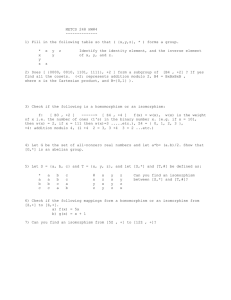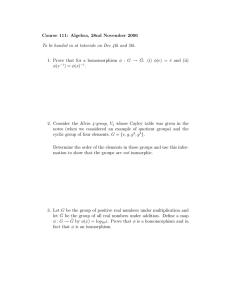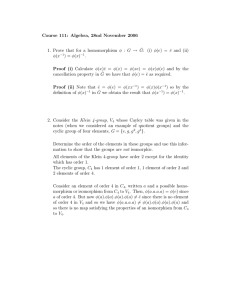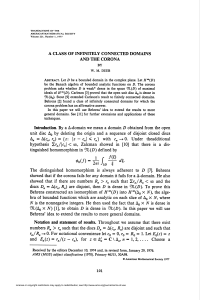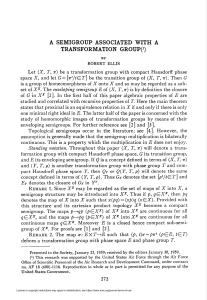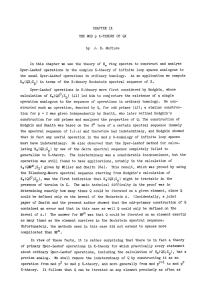Lemma: Let M be an S A-module, which may be regarded as an A
advertisement
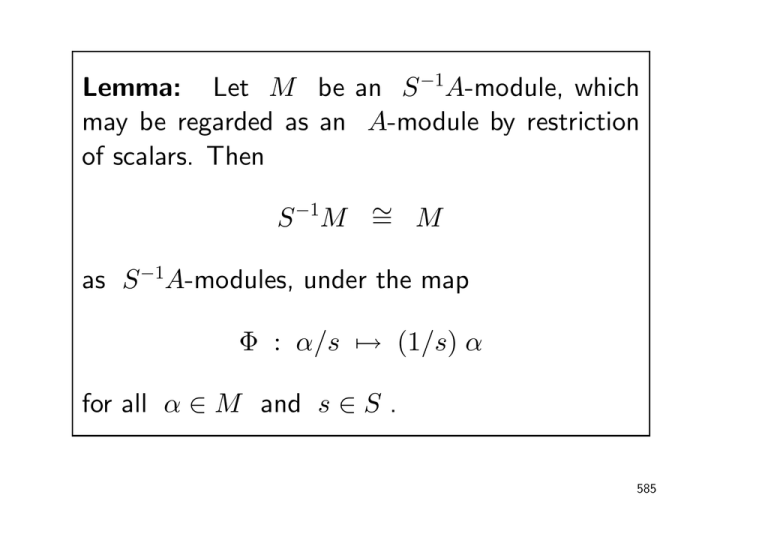
Lemma: Let M be an S −1A-module, which may be regarded as an A-module by restriction of scalars. Then S −1M ∼ = M as S −1A-modules, under the map Φ : α/s 7→ (1/s) α for all α ∈ M and s ∈ S . 585 Proof: Observe that Φ is well-defined and one-one because α/s = α′/s′ ⇐⇒ t · (s′ · α − s · α′) = 0 ⇐⇒ ′ ′ (t/1) (s /1) α − (s/1) α = 0 ⇐⇒ (s′/1) α − (s/1) α′ = 0 , (∃t ∈ S) 586 so α/s = α′/s′ ⇐⇒ (s′/1) α = (s/1) α′ ⇐⇒ (1/s) α = (1/s′) α′ , and Φ is onto because (∀α ∈ M ) Φ(α/1) = (1/1)α = α . It is routine to check that Φ preserves module operations, completing the proof of the Lemma. 587 Now we can prove that taking fractions “commutes” with taking tensors: Theorem: Let M , N be A-modules. Then there is a unique isomophism of S −1A-modules f : S −1M ⊗S −1A S −1N −→ S −1(M ⊗A N ) such that f α/s ⊗ β/t = α ⊗ β / st . 588 Proof: Define f ′ : S −1M × S −1N −→ S −1(M ⊗A N ) by (α/s , β/t) 7→ α ⊗ β / st . This is well-defined, because if α/s = α′/s′ , β/t = β ′/t′ then 589 u(s′α − sα′) = 0 (∃u ∈ S) v(t′β − tβ ′) = 0 so ′ us α = usα ′ (∃v ∈ S) ′ ′ vt β = vtβ , and yielding ′ ′ us vt α ⊗ β α ⊗β / st = u s′ v t′ st 590 u s′ v t′ (α ⊗ β) (u s′ α) ⊗ (v t′ β) = = ′ ′ us vt st u s′ v t′ s t u s v t (α′ ⊗ β ′) (u s α′) ⊗ (v t β ′) = = ′ ′ usvts t u s v t s′ t′ ′ usvt α ⊗ β = usvt s′ t′ ′ = α′ ⊗ β ′ / s′ t′ . It is routine to check that f ′ is S −1A-bilinear. 591 Hence there is a unique S −1A-module homomorphism f which makes the following diagram commute: −1 −1 S M ×S N f′ S −1M ⊗S −1A S −1N f S −1(M ⊗A N ) that is, f α/s ⊗ β/t = f ′(α/s, β/t) = α ⊗ β / st . 592 It remains to show f is an isomorphism. Let h′ : M × N −→ S −1M ⊗S −1A S −1N where (α, β) 7→ α/1 ⊗ β/1 . It is easy to check that h′ is A-bilinear. Hence there is a unique A-module homomorphism h such that the following diagram commutes: 593 M ×N h′ M ⊗A N h S −1M ⊗S −1A S −1N that is, h(α ⊗ β) = h′(α, β) = α/1 ⊗ β/1 , and so 594 −1 S h : S −1 M ⊗A N −→ S −1 S −1M ⊗S −1A S −1N where −1 S h α⊗β s = α/1 ⊗ β/1 s . Now let Φ : S −1 S −1M ⊗S −1A S −1N −→ S −1M ⊗S −1A S −1N 595 be the isomorphism of the previous lemma, so Φ : θ/s 7→ (1/s) θ . Then −1 −1 Φ ◦ S h : S (M ⊗A N ) −→ −1 −1 S M ⊗S −1A S N where α⊗β α/1 ⊗ β/1 −1 Φ ◦ S h = Φ s s 596 = 1/s α/1 ⊗ β/1 = α/s ⊗ β/1 = α/1 ⊗ β/s . Put k = Φ ◦ S −1h . Thus f S −1M ⊗S −1A S −1N S −1 M ⊗A N k 597 Observe that α⊗β (k ◦ f ) α/s ⊗ β/t = k st 1 = st α/1 ⊗ β/1 1 1 = α/1 ⊗ β/1 s t 1 1 = α/1 ⊗ β/1 = α/s ⊗ β/t , s t 598 and (f ◦ k) α ⊗ β / s = f α/s ⊗ β/1 = α⊗β /s, so, since they fix generators, k ◦ f and f ◦ k are identity mappings on their respective domains, which proves that f is an isomorphism. 599
